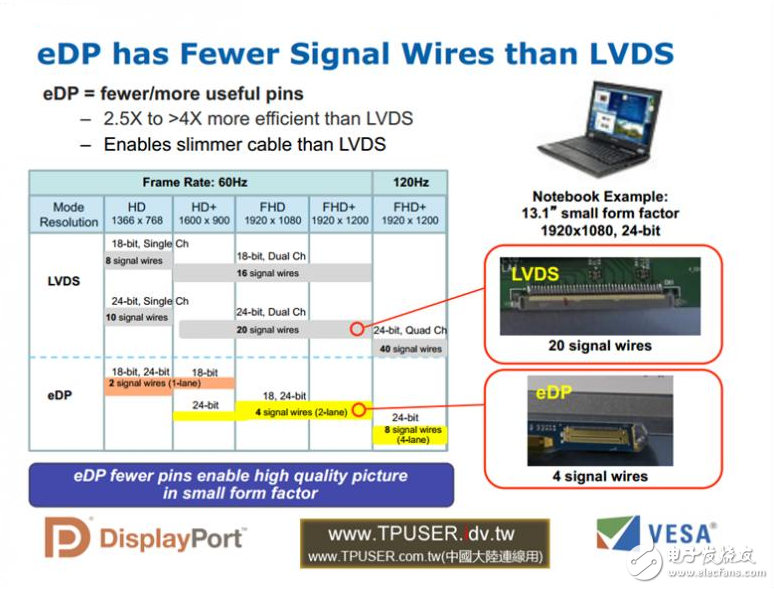EDP ​​is a communication interface of computer display. The resolution of computer with EDP display interface is higher than that of LVDS interface. Generally, high-definition screen adopts this communication interface, which means you can achieve the "wide viewing angle". "The function."
Both eDP and LVDS are video signal interfaces used in industrial computers to connect to touch screens or displays. The LVDS interface utilizes a very low voltage swing (approximately 350mV) for differential data transfer on two PCB traces or a pair of balanced cables, ie low voltage differential signaling. It is a digital video signal transmission method developed to overcome the shortcomings of high power consumption and large EMI electromagnetic interference when transmitting broadband high bit rate data in TTL level mode. The industrial computer adopts the LVDS output interface, which enables signals to be transmitted at a rate of several hundred Mbit/s on a differential PCB line or a balanced cable. Low-voltage and low-current driving are adopted to achieve low noise and low power consumption.
The eDP interface is an all-digital interface based on the DisplayPort architecture and protocol. It can transmit high-resolution signals with simple connectors and fewer pins, and can realize simultaneous transmission of multiple data, so the transmission rate is much higher. For LVDS.
eDP interface features:1. Micro-packet structure enables simultaneous transmission of multiple data.
2. No LVDS conversion circuit is required, and the circuit is simple.
3. Smaller EMI (electromagnetic interference) and powerful copyright protection.
Take the LCD screen with resolution of 1920x1200 and 24bit color as an example. If the LVDS interface is used, the data transmission line needs 20 pairs; if the eDP interface is used, only 4 pairs of lines are needed. It can be seen that the advantages of the eDP interface are quite obvious, especially in high-definition screens. In recent years, in order to improve the data transmission speed between the panel and the processor, the eDP interface has been widely used in the industrial computer and the industrial tablet computer, and the eDP interface is rapidly becoming the mainstream interface.
The difference between eDP screen line and LVDS screen lineThe eDP screen line refers to the screen interface of 0.3-0.5 small pitch welded flat wire, which is divided into single channel and dual channel. The eDP screen line is generally 2 sets of stranded wires, 3 sets of stranded wires, 5 sets of stranded wires, and 8 sets of strands. Common eDP screen lines are 2 sets of signal lines (stranded lines) and 3 sets of signal lines.
The LVDS screen line is divided into standard definition line and high definition line. LVDS screen line (HD line) screen interface is 0.5 pitch double row, namely JAE FIRE51P HD line. LVDS screen line (standard line) means that the screen interface is 1.0 pitch, 1.25 pitch, and the terminals are assembled by riveting. Commonly there are single eight lines and double eight lines. Most of the single eight lines are FIX-30P and DF141.25-30P, and most of the double eight lines are FIX-30Pin.
Explore the possibilities of upgrading the X220/X230, or other existing laptops, to upgrade higher resolution panels. After all, upgrading the built-in screen of the notebook is completely different from upgrading the external external screen. In many cases, it is not a flat cable that can be easily solved.
The first is the physical limitation. After all, the A shell (front shell) and B shell (screen bezel) of the notebook are fixed in size. The inside of the A shell also needs to accommodate flat cable, WLAN and WWAN antenna, ThinkLight night light, etc. It has reached the extreme, it is impossible to install an LCD panel with a larger size or a wrong aspect ratio. So often asked LG LP129QE1-SPA1 (12.9å‹15:10 2560&TImes; 1700), because the size is larger, and the aspect ratio does not meet the 16:9 of the original panel, if forced to install, the top and bottom of the screen will not plug Go in, so I can't think about it at all.
The second is the BIOS limitation. If your laptop screen is an old LVDS interface, you must have the corresponding BIOS to properly drive the panel power, output the correct resolution, and so on. Before replacing the high-resolution AFFS panel with the X60/X61, it is the best example. If you install the AFFS panel with the same resolution as the original screen, just find the flat cable adapter and add the small border of the screen to cut it off. These two skills can be. If you change the 1440&TImes; 1050 high-resolution AFFS panel, there is still a step to brush the modified BIOS. If the BIOS is not properly supported, different resolution panels may not work properly.
Take the 1366 & TImes; 768 resolution panel of the original X220/X230 as an example. Only a single-channel LVDS flat cable is required for connection. To support high-resolution LCD panels of 1440&TImes; 900 or higher, a 29-wire dual-channel LVDS flat cable must be used, of which 16 wires are used for signal transmission, and there is a way to cope with high-resolution images. (Note: 18-bit=panel 6-bit color depth x3, 24-bit=panel 8-bit color depth x3.)

Dust Explosion Proof Motor,Explosion Proof Induction Ac Motor,Special Explosion-Proof Motor,Dust Explosion Protection Motors
Yizheng Beide Material Co., Ltd. , https://www.beidevendor.com
